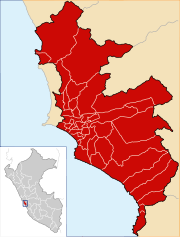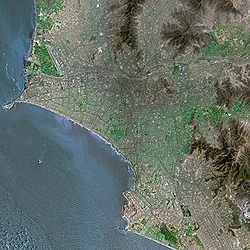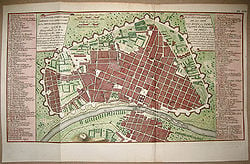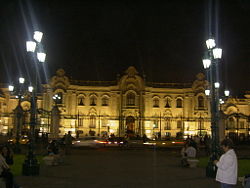Difference between revisions of "Lima" - New World Encyclopedia
Mike Butler (talk | contribs) |
Mike Butler (talk | contribs) |
||
| Line 125: | Line 125: | ||
The city center is located 15 km inland at the shore of the Rimac river, a vital resource for the city, since it carries what will become drinking water for its inhabitants and fuels the hydroelectrical dams that provide electricity to the area. | The city center is located 15 km inland at the shore of the Rimac river, a vital resource for the city, since it carries what will become drinking water for its inhabitants and fuels the hydroelectrical dams that provide electricity to the area. | ||
| − | + | Districts | |
| − | |||
| − | |||
| − | |||
| − | |||
| − | |||
| − | |||
| − | |||
| − | |||
| − | |||
| − | |||
| − | |||
| − | |||
| − | |||
| − | |||
==History== | ==History== | ||
| Line 190: | Line 176: | ||
==Demographics== | ==Demographics== | ||
{{Main|Demographics of Lima}} | {{Main|Demographics of Lima}} | ||
| − | [[Image:Lima PuebloJov 4.jpg|right| | + | [[Image:IMAG0008-1.JPG|thumb|right|250px|Church in the Magdalena del Mar district.]] |
| + | [[Image:Lima PuebloJov 4.jpg|thumb|right|250px|Slums in the outskirts of Lima.]] | ||
Population, population rank | Population, population rank | ||
Race/ethnicity - historical background of ethnic groups | Race/ethnicity - historical background of ethnic groups | ||
Revision as of 02:46, 8 September 2008
| Lima | |||
|
|||
| Nickname: City of the Kings | |||
| Motto: Hoc signum vere regum est | |||
| Lima Province and Lima within Peru | |||
| Coordinates: 12°02.6′S 77°1.7′W | |||
|---|---|---|---|
| Country | |||
| Region | Lima Region | ||
| Province | Lima Province | ||
| Settled | January 18, 1535 | ||
| Government | |||
| - Mayor | Luis Castañeda Lossio | ||
| Area | |||
| - City | 804.3 km² (310.5 sq mi) | ||
| - Water | 75.7 km² (29.2 sq mi) 5.8% | ||
| - Urban | 4,319.9 km² (1,667.9 sq mi) | ||
| Elevation | 0 - 1,548 m (0 - 5,079 ft) | ||
| Population (2006)[1][2] | |||
| - City | 7,819,436 | ||
| - Density | 8,544/km² (22,128.9/sq mi) | ||
| - Urban | 7,629,407 | ||
| - Metro | 9,241,961 | ||
| Time zone | PET (UTC-5) | ||
| Website: www.munlima.gob.pe | |||
Lima, the capital and largest city of Peru, is the country’s commercial and industrial centre. It is located in the valleys of the Chillón, Rímac and Lurín rivers, on a coast overlooking the Pacific Ocean. It forms a contiguous urban area with the seaport of Callao, which is about eight miles (13km) away on the Pacific coast.
Lima was founded by Spanish conquistador Francisco Pizarro on January 18, 1535, as La Ciudad de los Reyes, or "The City of Kings." It became the most important city in the Spanish Viceroyalty of Peru and, after the Peruvian War of Independence, was made the capital of the Republic of Peru. Today around one-third of the Peruvian population lives in the metropolitan area.
Geography
The name Lima may derive from the Quechuan name Rimac ("Talking river"), which is the name of the river that feeds Lima. Some speculate that the Spanish created the word Lima in trying to say Rimac, which they heard from local inhabitants. On the oldest Spanish maps of Peru, both Lima and Ciudad de los Reyes can be seen together as names for the city.
The urban area of Lima covers about 800 km². It is located on mostly flat terrain in the Peruvian coastal plain, within the valleys of the Chillón, Rímac and Lurín rivers. The city slopes gently from the shores of the Pacific Ocean into valleys and mountain slopes located as high as 1640 feet (500 meters) above mean sea level. Within the city exist isolated hills which are not connected to the surrounding hill chains, such as El Agustino, San Cosme, El Pino, La Milla, Muleria and Pro hills. The San Cristobal hill in the Rimac district, which faces directly north of the downtown area, is the local extreme of an Andean hill outgrowth.
Lima is an oasis in a barren, unvegetated desert of grayish-yellow sands.
Although Lima is located in the tropics, the cool offshore Humboldt Current creates a temperate climate with high humidity. The temperatures vary from mild to warm (neither very cold or hot). The average maximum daytime temperature in January is 82.4°F (28°C), dropping to an average maximum of around 66.2°F (19°C) in June. Relative humidity is very high, and produces brief morning fog from June to December and persistent low clouds from May to November. The peak of the "rainy season" occurs during winter when late-night/morning drizzle events (locally called 'garúa','llovizna' or 'camanchacas') become frequent, leaving a light coating of dampness on the ground. Mean annual precipitation is 1.69 inches (43mm).
Rapid population growth has brought problems of air pollution, resulting from too many buses and cars. the high humidity is oxidation, rust being a common sight.
Metropolitan Lima has an area of 1031.77 square miles (2672.28 square kilometers), of which 318.87 square miles (825.88 square kilometers), or 31 percent, comprises the actual city and 712.8 square miles (1846.40 square kilometers), 69 percent, the city outskirts. The urban area extends around 60km from north to south and around 30km from west to east.
The city center is located 15 km inland at the shore of the Rimac river, a vital resource for the city, since it carries what will become drinking water for its inhabitants and fuels the hydroelectrical dams that provide electricity to the area.
Districts
History
During the early 16th century, the location of what is now the city of Lima was inhabited by several amerindian groups under the domination of the Inca Empire. In 1532, a group of Spanish conquistadors led by Francisco Pizarro defeated the Inca ruler and took over his empire. Pizarro initially chose the city of Jauja as his capital but found a better site in the valley of the Rímac River. There he founded his new capital on January 18, 1535 as Ciudad de los Reyes. The city gained prestige as it was designated capital of the Viceroyalty of Peru and site of a Real Audiencia in 1543. The Western Hemisphere's first university, San Marcos University was established in 1551 and its first printing press in 1584. It also became an important religious center, a Roman Catholic diocese was established in 1541 and converted to an archdiocese five years later.
The city flourished during the 17th century as the center of an extensive trade network which extended as far as Europe and the Philippines.[3] However, it also suffered considerable damage from two earthquakes in 1630 and 1687. A constant danger to the city's commerce was the presence of pirates and privateers in the Pacific Ocean. To protect the city against them, Viceroy Melchor de Navarra y Rocafull built a wall around it between 1684 and 1687. In the 18th century, Lima had to be rebuilt after being almost completely destroyed by an earthquake on October 28, 1746. This natural disaster led to the appearance of an intense devotion for the Lord of the Miracles, which has endured until today.
On July 28, 1821, José de San Martín declared the independence of Peru. After the war, endemic political turmoil and lack of economic stability slowed Lima's recovery. In the mid 19th century, an economic boom sustained by guano exports allowed for several improvements to the city. In 1872, the city walls were torn down to make way for the expansion of the city. During the 1879–1883 War of the Pacific, Chilean troops occupied Lima after defeating Peruvian resistance in the battles of San Juan and Miraflores destroying and burning some parts of the city. The city went through a process of urban renewal and expansion from the 1890s up to the 1920s. In the 1940s, the city started a period of rapid growth spurred by immigration from the Andean regions of Peru. Population, estimated at 600,000 in 1940, doubled by 1960 and again by 1980. Growth far outstripped public services development, giving rise to large shanty towns, known as pueblos jóvenes, some of which have developed their infrastructure and become incorporated into Lima proper.
Government
Peru is a constitutional republic. The president is both the chief of state and head of government, and is elected by popular vote for a five-year term, being eligible for a nonconsecutive reelection. The unicameral Congress of the Republic of Peru has 120 members elected by popular vote to serve five-year terms.
While no official administrative definition for the city exists, it is usually considered to be composed of the central 30 out of the 43 districts of Lima Province, corresponding to an urban area centered around the historic Cercado de Lima district. The city is the core of the Lima Metropolitan Area, one of the ten largest metropolitan areas in the Americas.
Lima is made up of thirty densely-populated districts, each headed by a local mayor and the Mayor of Lima, whose authority extends to these and the thirteen outer districts of the Lima province.
Economy
Abundant mineral resources are found in Peru's mountainous areas, and coastal waters provide excellent fishing grounds. However, overdependence on minerals and metals subjects the economy to fluctuations in world prices, and a lack of infrastructure deters trade and investment. The Peruvian economy grew by more than four percent each year during the period 2002-06, with a stable exchange rate and low inflation. Even so, underemployment and poverty have stayed persistently high. Peru's per capita GDP was estimated at $7800 in 2007.
Per capita GDP, rank Financial and business services sector Tourism Manufacturing Transport: Road, rail, air, sea
Lima is the industrial and financial center of Peru. It contains more than two thirds of its industrial production and most of its tertiary sector, and is home to many national companies.
The Metropolitan area, with around 7000 factories, spearheads the industrial development of the country, thanks to the quantity and quality of the available workforce, cheap infrastructure and the mostly developed routes and highways in the city. The most relevant industrial sectors are textiles, clothing and food. Chemicals, fish, leather and oil derivatives are also manufactured and/or processed in Lima. The financial district is located in the district of San Isidro, while much of the industrial activity takes place in the area stretching west of Downtown Lima to the airport in Callao.
The Callao seaport is one of the main fishing and commerce ports in South America, with 75% of the country's imports and exports using it as their entry/departure point. The main export goods leaving the country through Callao are oil, steel, silver, zinc, cotton, sugar and coffee.
In 2004, Lima's GDP represented 45% of the country's GDP (5% more than the previous year). The GDP per capita was also higher in Lima (3525 dollars) than in the rest of the country (2625 dollars). Most of the foreign companies operating in the country have settled in Lima, which has led to the previously mentioned concentration of economic and financial activity on the city.
Transport
Lima is connected to the rest of the country via two main highways: the Pan-American Highway (Carretera Panamericana) and the Central Highway (Carretera Central). There are three expressways in the city; they are located at Grau, Javier Prado, and Paseo de la República avenues. Lima has a rapid transit rail system under development called the Lima Metro. This project was paralyzed in the late 1980s due to lack of funds but is now expected to be relaunched with private funding. The Metropolitan Transportation System (Sistema de Transporte Metropolitano), is an urban transport project that envisages the implementation of Corridors of High Capacity Buses (COSAC) through Lima. The COSAC-South Corridor I is currently under implementation, it runs for 15 kilometers between Construction Matenilli in Chorrillos and the Plaza Grau in downtown Lima.
Public transport in Lima is handled by buses, micros, taxicabs, and the so-called mototaxis. Micros are the most common means of public transportation in Lima and many other cities in Peru. The word micro is used in common-day Peruvian Spanish as an abbreviation for microbus (minibus). While the bigger vehicles are known as micros, the smaller ones are known as combis. These privately-owned vehicles are known for being cheap and convenient but also rather risky. Due to large margins of unemployment faced Peru in the eighties, the free importation of used cars and the fact that no authorization is required to provide municipal services, there is an over-supply of taxis.
Lima is serviced by air through Jorge Chávez International Airport, Peru's main hub for both national and international air traffic.[4]
Demographics
Population, population rank Race/ethnicity - historical background of ethnic groups Language Religion Colleges and universities
Lima ranks as the nineteenth most populous city in the world with an estimated population of 7.6 million for the urban area, 7.8 million for the entire province, and 9.2 million for the metropolitan area as of 2005.[5] Its population features a very complex mix of racial and ethnic groups. Traditionally, Mestizos of mixed European (mostly Spanish) and Amerindian descent are the largest contingent. The second group has its origins in Europe, mostly of Spanish descent, but there are significant numbers of Italians, Germans, Jews, and Middle Easterners.
The first settlement in what would become Lima was made up of only 117 housing blocks. In 1562, another district was built at the other side of the Rimac River and in 1610, the first stone bridge was built. Lima had, at this point in time, around 1600 inhabitants. In 1861, the amount of inhabitants surpassed 100,000, and by 1927 this amount was doubled.
During the early twenty century thousands of immigrants came to the city, a significant number of French, Italians and Germans, many of them had been adapting to the Peruvian society. They organized in social clubs, and they built their own schools; for example, The American Peruvian school which is located in Miraflores, The French Alliance (Alianza Francesa de Lima) and the hospital Maison de Sante. They also influenced Peruvian cuisine, the Italians in particular exerting a strong influence in the Miraflores and San Isidro areas with their restaurants, called Trattorias.
A great number of Chinese immigrants, and a lesser amount of Japanese, came to Lima and established themselves in the Barrios Altos neighborhood near downtown Lima, coming in order to work on farms and domestic services.[citation needed] Lima residents refer to their Chinatown as "Calle Capon," and the city's ubiquitous Chifa restaurants – a small, sit-down, usually Chinese-run restaurant serving the Peruvian spin on Chinese cuisine – can be found by the dozen in this Chinese enclave.
The 1950s saw the exponential increase of the city inhabitants, most of them Andean immigrants and their descendants, who settled in the northern and southern outskirts.[citation needed] The political and economic instability in Peru during the latter half of the twentieth century created unprecedented poverty and violence in the towns of the countryside or Andean highlands, forcing hundreds of thousands of peasants of Amerindian descent to migrate to Lima – thus greatly augmenting Lima's population.[6] In the 70’s, the lacking transportation facilities for the newcomers who had to travel for hours on end to reach the city center became a problem, and it was decided that Lima should not expand any further.
Unlike other ethnic groups in Lima who speak only Spanish, most of the peasant population that migrated to Lima speaks primarily Quechua or Aymara, rather than Spanish. While a number of Amerindians eventually attain middle class status, others still live in shantytowns, known locally as pueblos jóvenes (young towns). These areas often lack such basic services as electricity and running water. Afro-Peruvians, whose African ancestors were initially brought to the region as slaves, are yet another part of the city's ethnic quilt, and Asians, an even smaller one.
Education
The city has the largest concentration of higher-education institutions in the country (28 universities) and schools with world-wide recognition. The National University of San Marcos, founded on May 12 1551 during Spanish colonial regime, is the oldest continuously functioning university in the Americas. Other public universities also play key roles in teaching and research, such as the Universidad Nacional Agraria La Molina where ex-president Alberto Fujimori once taught, Universidad Nacional de Ingeniería, among others. The Pontificia Universidad Católica del Perú, established in 1917, is the oldest private university. Other private institutions that are located in the city are Universidad de Lima, Universidad Científica del Sur, Universidad San Martín de Porres, Universidad del Pacifico, Universidad Inca Garcilaso de la Vega, Universidad Peruana Cayetano Heredia, Universidad Peruana de Ciencias Aplicadas and Universidad Ricardo Palma.
Of interest
The Historic centre of Lima was declared a UNESCO World Heritage Site in 1988 due to its large number of historical buildings dating from the Spanish colonial era. In particular, the Plaza Mayor, with the 16th century Cathedral and the Presidential Palace, and the catacombs of the Convento de San Francisco are popular tourist attractions. Like many other world capitals, Lima is home to the most prestigious national museums, including the National Museum of Anthropology, Archeology, and History and the Rafael Larco Herrera Archaeological Museum, both in the Pueblo Libre district, the Museum of the Nation, the Museum of Art, the Museum of Italian Art, the Museum of the Inquisition, and many others.
Many small beaches, which are heavily visited during the summer months, are located along the southern Pan-American Highway. The most well-known ones are located in the districts of Santa María del Mar, Punta Hermosa, Punta Negra, San Bartolo and Pucusana. Lima's wealthy families usually go during summer to the highly exclusive beaches of Asia 97 kilometers south of Lima. Also, the district of Ancón, located north of the city, has a very popular beach resort. Numerous restaurants, clubs and hotels have been opened in these places to serve the many beachgoers. Lima residents also flock to the beaches in the Miraflores district.
The suburban district of Cieneguilla and the town of Chosica (in the Lurigancho District) provide attractive green landscapes at a short distance from the city. Because of their elevation (over 500 meters), the sun shines in these areas even during winter and hence they are visited by residents of Lima to escape from the winter fog.
Lima has a world renowned cuisine, which fuses Andean and Spanish culinary traditions, as well as some African, Asian (mainly Chinese and Japanese), French, Italian and Muslim cuisine. The city is rapidly becoming world-famous for its seafood and unique vegetables, Creole, Peruvian–Chinese (called chifa) and fusion cuisine.
See also
- Lima Metropolitan Area
- List of people from Lima
- List of districts and neighborhoods of Lima
- List of sites of interest in the Lima Metropolitan area
Notes
- ↑ Citypopulation.de Lima related information
- ↑ www.emporis.com population charts
- ↑ Margarita Suárez, Desafíos transatlánticos, pp. 252–253.
- ↑ Lima Airport Partners, Annual Report. Retrieved on July 8, 2007
- ↑ INEI - Por AÑOS ESTIMACIONES Y PROYECCIONES (2005)
- ↑ Instituto Nacional de Estadistica e Informatica
Further reading
External links
- World Fact Book 2008 Peru Retrieved September 6, 2008.
- (Spanish) Municipality of Lima
- Geographia.com
- (Spanish) Maps
- Stock Exchange
- Travel guide to Lima from Wikitravel
Credits
New World Encyclopedia writers and editors rewrote and completed the Wikipedia article in accordance with New World Encyclopedia standards. This article abides by terms of the Creative Commons CC-by-sa 3.0 License (CC-by-sa), which may be used and disseminated with proper attribution. Credit is due under the terms of this license that can reference both the New World Encyclopedia contributors and the selfless volunteer contributors of the Wikimedia Foundation. To cite this article click here for a list of acceptable citing formats.The history of earlier contributions by wikipedians is accessible to researchers here:
The history of this article since it was imported to New World Encyclopedia:
Note: Some restrictions may apply to use of individual images which are separately licensed.









